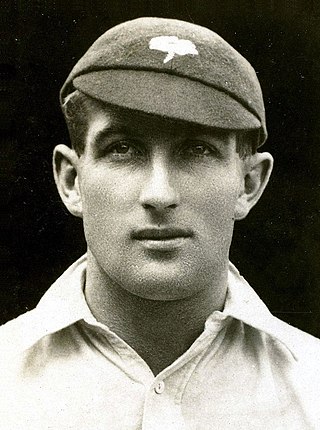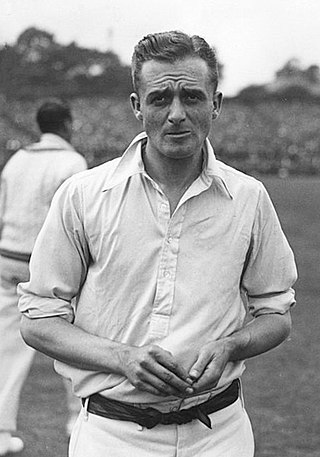This article needs additional citations for verification .(January 2014) |
Woodhouse Hill was a stadium in the Hunslet district of Leeds which was used for cricket and rugby football.
This article needs additional citations for verification .(January 2014) |
Woodhouse Hill was a stadium in the Hunslet district of Leeds which was used for cricket and rugby football.
In the 1860s a cricket team named "Evening Star" used to play on Hunslet Moor. Later it moved to Woodhouse Hill, the home of another cricket club, "The Peep of Day C.C.".
Woodhouse Hill was an enclosure adjacent to the Cemetery Tavern (now The Parnaby Tavern). Sometime later Evening Star changed its name to Hunslet C.C. It became an important Yorkshire club, and Australian teams played at Woodhouse Hill in 1868, 1878 and 1880.
In 1884, Hunslet built a stand. It was re-erected in Parkside when the club moved.

Woodhouse Hill Cricket Ground held two first class cricket matches . In July 1869 Yorkshire CCC played Cambridgeshire while a United North of England Eleven took on a United South of England Eleven in 1872.
Roger Iddison scored a century in the county match but the match winner was Tom Emmett who took 9-23 and 7 for 15 for Yorkshire. His match figures of 16 for 38 in 35.2 overs in Yorkshire's innings victory are remarkable and he also scored an unbeaten 47 at number 11 in a partnership of 72 for the last wicket . Emmett's 9 for 23 were his best innings figures in a career which saw him take 1572 first class wickets at just 13.55.
The last cricket on the ground was played in 1888 and Woodhouse Hill was later lost to building development, part is now under the M621.
A special general meeting of the Hunslet Cricket Club was held on 21 May 1883, the committee resolved to grant two local teams: Albion and Excelsior the sum of £30 to form the rugby club Hunslet based at Woodhouse Hill. The name of the cricket club was also changed to 'Hunslet Cricket and Football Club'.
Hunslet announced their arrival the following season by beating Leeds St John's (later to become Leeds Rhinos) in the third round of the Yorkshire Cup. Better fixtures drew larger crowds and as a result the landlord wanted to put up the rent. The search was on for another ground, club officials purchased at little cost 10.25 acres (41,500 m2) of waste land at Hunslet Carr from the Low Moor Iron and Coal Company and had to shift 2,000 tons of rubbish to create what would become Parkside, which they moved to in 1888.

Yorkshire County Cricket Club is one of eighteen first-class county clubs within the domestic cricket structure of England and Wales. It represents the historic county of Yorkshire. Yorkshire's first team is the most successful in English cricketing history with 33 County Championship titles, including one shared. The team's most recent Championship title was in 2015. The club's limited overs team is called the Yorkshire Vikings and their kit colours are Cambridge blue, Oxford blue, and yellow.

The Leeds Rhinos are a professional rugby league club in Leeds, West Yorkshire, England. The club play their home games at AMT Headingley Rugby Stadium and compete in the Super League, the top tier of British rugby league.

Robert Peel was an English professional cricketer who played first-class cricket for Yorkshire between 1883 and 1897. Primarily a left-arm spin bowler, Peel was also an effective left-handed batsman who played in the middle order. Between 1884 and 1896, he was regularly selected to represent England, playing 20 Test matches in which he took 101 wickets. Over the course of his career, he scored 12,191 runs and took 1,775 wickets in first-class cricket. A match-winning bowler, particularly when conditions favoured his style, Peel generally opened the attack, an orthodox tactic for a spinner at the time, and was highly regarded by critics.

Hunslet R.L.F.C. is a professional rugby league club in Beeston, Leeds, West Yorkshire, England. They play home games at South Leeds Stadium and compete in League One, the third tier of British rugby league.

Abraham "Abe" Waddington, sometimes known as Abram Waddington, was a professional cricketer for Yorkshire, who played in two Test matches for England, both against Australia in 1920–21. Between 1919 and 1927 Waddington made 255 appearances for Yorkshire, and in all first-class cricket played 266 matches. In these games, he took a total of 852 wickets with his left arm fast-medium bowling. Capable of making the ball swing, Waddington was admired for the aesthetic quality of his bowling action. He was a hostile bowler who sometimes sledged opposing batsmen and questioned umpires' decisions, behaviour which was unusual during his playing days.

George Gibson Macaulay was a professional English cricketer who played first-class cricket for Yorkshire County Cricket Club between 1920 and 1935. He played in eight Test matches for England from 1923 to 1933, achieving the rare feat of taking a wicket with his first ball in Test cricket. One of the five Wisden Cricketers of the Year in 1924, he took 1,838 first-class wickets at an average of 17.64 including four hat-tricks.

Ephraim Lockwood was an English first-class cricketer, and captain of Yorkshire County Cricket Club in the 1876 and 1877 seasons.
Harold Buck was an English professional rugby league footballer who played in the 1910s and 1920s. He played at club level for Hunslet and Leeds, as a wing.

George Freeman was an English first-class cricketer. He made 32 appearances for Yorkshire County Cricket Club from 1865 to 1880. He also played four matches of first-class cricket for the "United England Eleven" (1866–1869), three games for the "North of England" (1867–1869), four for the "United North of England Eleven" (1870) plus one for the "Players" (1871).
Henry Mosley was an English first-class cricketer, who played two matches for Yorkshire County Cricket Club in 1881, and another for T Emmett's XI v Alfred Shaw's XI at Bradford in the same year.

Park Avenue is a sports ground on Horton Park Avenue in Bradford, West Yorkshire, England that has been used for cricket, football and both codes of rugby. Yorkshire regularly played cricket matches at the ground between 1881 and 1996, while the site was also home to former Football League club Bradford, to which it lent its name.
Parkside was a rugby league stadium in Hunslet, Leeds, England. It was home to Hunslet F.C. rugby league club and the source of their nickname, the Parksiders.

Leslie Llewellyn White was a Welsh professional rugby league footballer who played in the 1920s, 1930s and 1940s. He played at representative level for Great Britain, Wales, England, and at club level for Pontypridd and Hunslet, as a hooker. Les White was also a lance corporal in the British Army during World War II.
The United North of England Eleven (UNEE) was an itinerant cricket team founded in 1869 by George Freeman and Roger Iddison with the backing of Lord Londesborough who became the team's president. As its name suggests, its purpose was to bring together the best players of England's northern counties and play against all-comers. The team was thus one of several spinoffs from William Clarke's original All-England Eleven (AEE).
The United South of England Eleven (USEE) was an itinerant cricket team founded in November 1864 by Edgar Willsher, as secretary, and John Lillywhite, as treasurer. The USEE had no home venue as its prime purpose, like all similarly named teams of the time, was to operate as a travelling show and bring top-class cricket to places in Great Britain and Ireland which rarely received it. Fourteen USEE matches have been recognised by CricketArchive as first-class, mostly against the rival United North of England Eleven (UNEE). The USEE is estimated to have played 217 "odds" matches as a visiting team against local club sides which generally used 22 players.

Frank Watson, also known by the nickname of "Shanks", was an English professional rugby league footballer who played in the 1940s and 1950s, and coached in the 1950s and 1960s. He played at representative level for Yorkshire, and at club level for Hunslet, York, Leeds, and Batley, as a centre or scrum-half. and coached at club level for Leeds (A-Team), and Batley.
The Yorkshire Rugby Football Union is the governing body responsible for rugby union in the historic county of Yorkshire, England. It is one of the constituent bodies of the national Rugby Football Union having formed in 1869, the union was formerly called Yorkshire County Club.

Headingley Cricket Ground is a cricket ground in the Headingley Stadium complex in Headingley, Leeds, England. It adjoins the Headingley Rugby Stadium through a shared main stand, although the main entrance to the cricket ground is at the opposite Kirkstall Lane end. It has hosted Test cricket since 1899 and has a capacity of 18,350.
Hunslet F.C. was a professional rugby league club based in Hunslet, Leeds, West Yorkshire, England. The club was a founding member of the Rugby Football League in 1895.

Hunslet Club Parkside was an English amateur rugby league club based in Hunslet, West Yorkshire. Its first team competed in the National Conference League.